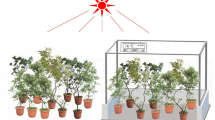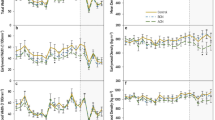Abstract
The carbon/nutrient balance hypothesis (CNBH) attempts to explain the mechanism of induced changes in plant properties. The responses of the Japanese larch (Larix kaempferi) to defoliation by the larch sawfly (Pristiphora erichsonii) were examined from the perspective of the CNBH. This study was conducted in seven Japanese larch plantations in central Hokkaido, Japan. The defoliation intensity was determined from canopy photos taken from 2009 to 2012. The chemical and physical properties of the foliage were determined from 2010 to 2012. Severe insect defoliation was found at two sites in 2009 and at all seven sites in 2010 and 2011. A decrease in foliar nitrogen and increases in phenolics, tannins, and the CN ratio were found in the years following severe defoliation and were significantly influenced by the 2009 defoliation intensity. The influence of defoliation in 2010 and 2011 was weaker. These results indicated that the past defoliation history additively affected the foliage properties in the 2 years following insect defoliation. In addition to the 2009 defoliation effects, site effects were found on phenolics, sugars, and the CN ratio. Relative to the other sites, the CN ratio was high at both sites where severe defoliation was found in 2009. Phenolics and sugars did not increase linearly with the CN ratio, indicating that limitations affected their synthesis. These results suggest that the induced changes in L. kaempferi properties are partially up-regulated under nitrogen limitation, but that secondary compound synthesis was, most likely, influenced by external site-dependent factors other than nitrogen limitation.



Similar content being viewed by others
References
Baltensweiler W, Benz G, Bovey P, Delucchi V (1977) Dynamics of larch bud moth populations. Annu Rev Entomol 22:79–100
Berenbaum MR (1983) Effects of tannins on growth and digestion in two species of papilionids. Entomol Exp Appl 34:245–250
Bryant JP, Chapin FS III, Klein DR (1983) Carbon/nutrient balance of boreal plants in relation to vertebrate herbivory. Oikos 40:14–368
Bryant JP, Heitkonig I, Kuropat P, Owen-Smith N (1991) Effects of severe defoliation on the long-term resistance to insect attack and on leaf chemistry in six woody species of the southern African savanna. Am Nat 137:50–63
Buckner CH (1956) Mamalian predators of the larch sawfly in Eastern Manitoba. In: Edward CB (ed) Proceedings of 10th International Congress of Entomology, vol 4. Government of Canada, Montreal, pp 353–361
Chapman RF (2003) Contact chemoreception in feeding by phytophagous insects. Annu Rev Entomol 48:455–484
Chapman L (2007) Potential applications of near infra-red hemispherical imagery in forest environments. Agric For Meteorol 143:151–156
Chow PS, Landhäusser SM (2004) A method for routine measurements of total sugar and starch content in woody plant tissues. Tree Physiol 24:1129–1136
Clancy KM (1992) The role of sugars in western spruce budworm nutritional ecology. Ecol Entomol 17:189–197
Clancy KM, Wagner MR, Tinus RW (1988) Variation in host foliage nutrient concentrations in relation to western spruce budworm herbivory. Can J For Res 18:530–539
Clancy KM, Chen Z, Kolb TE (2003) Effects of ortet genotype and western spruce budworm defoliation on foliar nutrients in Douglas-fir clones. In: Kamata N, Liebhold AM, Quiring DT, Clancy KM (eds) Proceeding: International symposium of IUFRO Kanazawa 2003 “Forest insect population dynamics and host influences”. Kanazawa University, Kanazawa, pp 37–44
Clancy KM, Chen Z, Kolb TE (2004) Foliar nutrients and induced susceptibility: genetic mechanisms of Douglas-fir resistance to western spruce budworm defoliation. Can J For Res 34:939–949
Cork SJ, Krockenberger AK (1991) Methods and pitfalls of extracting condensed tannins and other phenolics from plants: insights from investigations on Eucalyptus leaves. J Chem Ecol 17:123–134
Dahlsten DL (1967) Preliminary life tables for pine sawflies in the Neodiprion fulviceps Complex (Hymenoptera: Diprionidae). Ecology 48:275–289
David RS (1993) Systematics, life history, and distribution of sawflies. In: Wagner MR, Raffa KF (eds) Sawfly life history adaptations to woody plants. Academic, California, pp 3–32
Drooz AT (1960) The larch sawfly, its biology and control. United States department of agriculture. Tech Bull 1212:52
DuBois M, Gilles KA, Hamilton JK, Rebers PA, Smith F (1956) Colorimetric method for determination of sugars and related substances. Anal Chem 28:350–356
Feeny PP (1968) Effect of oak leaf tannins on larval growth of the winter moth Operophtera brumata. J Insect Physiol 14:805–817
Geri C, Allais J-P, Auger M-A (1993) Effects of plant chemistry and phenology on sawfly behavior and development. In: Wagner MR, Raffa KF (eds) Sawfly life history adaptations to woody plants. Academic, California, pp 211–227
Girardin MP, Tardif J, Bergeron Y (2001) Radial growth analysis of Larix laricina from the Lake Duparquet area, Quebec, in relation to climate and larch sawfly outbreaks. Ecoscience 8:127–138
Haukioja E (2003) How do birch defenses operate? In: Kamata N, Liebhold AM, Quiring DT, Clancy KM (eds) Proceeding: International symposium of IUFRO Kanazawa 2003 “forest insect population dynamics and host influences”. Kanazawa University, Kanazawa, pp 26–30
Haukioja E (2005) Plant defenses and population fluctuations of forest defoliators: mechanism-based scenarios. Ann Zool Fenn 42:313–325
Haukioja E, Niemelä P, Sirén S (1985) Foliage phenols and nitrogen in relation to growth, insect damage, and ability to recover after defoliation, in the mountain birch Betula pubescens ssp tortuosa. Oecologia 65:214–222
Higashiura Y (1990) Field damage and control of outbreaks of the larch sawfly, Pristiphora erichsonii, between 1977 and 1986. (1) The process of outbreaks and their damages. Hoppo Ringyo (Northern Forestry, Japan) 42:42–46 (in Japanese)
Hochuli DF (1996) The ecology of plant/insect interactions: implications of digestive strategy for feeding by phytophagous insects. Oikos 75:133–141
Howe GA, Schaller A (2008) Direct defenses in plants and their induction by wounding and insect herbivores. In: Schaller A (ed) Induced plant resistance to herbivory. Springer, Heidelberg, pp 7–29
Hunter AF, Lechowicz MJ (1992) Foliage quality changes during canopy development of some northern hardwood trees. Oecologia 89:316–323
Ives WGH (1976) The dynamics of larch sawfly (Hymenoptera:Tenthredinidae) populations in southeastern Manitoba. Can Entomol 108:701–730
Japan Meteorological Agency (2013) Weather, climate & earthquake information. http://www.data.jma.go.jp/obd/stats/etrn/. Accessed 27 Jan 2013
Jarzomski CM, Stamp NE, Bowers MD (2000) Effects of plant phenology, nutrients and herbivory on growth and defensive chemistry of plantain, Plantago lanceolata. Oikos 88:371–379
Kamata N (2002) Outbreaks of forest defoliating insects in Japan, 1950–2000. Bull Entomol Res 92:109–117
Kamata N, Igarashi Y, Ohara S (1996) Induced response of the Siebold’s beech (Fagus crenata Blume) to manual defoliation. J For Res 1:1–7
Karban R, Baldwin IT (1997) Induced responses to herbivory. University of Chicago Press, Chicago
Karban R, Myers JH (1989) Induced plant responses to herbivory. Annu Rev Ecol Syst 20:331–348
Koike T, Matsuki S, Matsumoto T, Yamaji K, Tobita H, Kitao M, Maruyama Y (2003) Bottom-up regulation for protection and conservation of forest ecosystems in northern Japan under changing environments. Euras J For Res 6–2:177–189
Lejeune RR (1947) Status of the larch sawfly, Pristiphora erichsonii Htg. in the Prairie Provinces. Can Entomol 79:130–134
Lowman MD, Box JD (1983) Variation in leaf toughness and phenolic content among five species of Australian rain forest trees. Aust J Ecol 8:17–25
Lynch AM (2012) What tree-ring reconstruction tells us about conifer defoliator outbreaks. In: Barbosa P, Letourneau DK, Agrawal AA (eds) Insect outbreaks revisited, 1st edn. Blackwell, Oxford, pp 126–154
Mattson WJ, Haack RA, Lawrence RK, Slocum SS (1991) Considering the nutritional ecology of the spruce budworm in its management. For Ecol Manag 39:183–210
Muldrew JA (1955) Parasites and insect predators of the larch sawfly. Can Entomol 87:117–120
Ozaki K, Fukuyama K, Isono M, Takao G (2004) Simultaneous outbreaks of three species of larch web-spinning sawflies: influences of weather and stand structure. For Ecol Manag 187:75–84
Pinheiro J, Bates D, DebRoy S, Sarkar D (2013) Package “nlme”, linear and nonlinear mixed effects models. R package version 3.1-113. http://cran.r-project.org/web/packages/nlme/index.html. Accessed 17 Nov 2013
Prop N (1960) Protection against birds and parasites in some species of tenthredinid larvae. Arch Neerl Zool 13:380–447
R Development Core Team (2012) R: a language and environment for statistical computing. R package version 2.14.2. http://www.R-project.org. Accessed 28 Mar 2012
Roitto M, Rautio P, Markkola A, Julkunen-tiitto R, Varama M, Saravesi K, Tuomi J (2009) Induced accumulation of phenolics and sawfly performance in Scots pine in response to previous defoliation. Tree Physiol 29:207–216
Rossiter M, Schultz JC, Baldwin IT (1988) Relationships among defoliation, red oak phenolics, and gypsy moth growth and reproduction. Ecology 69:267–277
Schofield P, Mbugua DM, Pell AN (2001) Analysis of condensed tannins: a review. Anim Feed Sci Technol 91:21–40
Smirnoff WA (1968) Diseases of the larch sawfly, Pristiphora erichsonii, in Quebec. J Invertebr Pathol 10:417–424
Stamp N (2003) Out of the quagmire of plant defense hypotheses. Q Rev Biol 78:23–55
Takata K, Kurinobu S, Koizumi A, Yasue K, Tamai Y, Kisanuki M (2005) Bibliography on Japanese larch (Larix kaempferi (Lamb.) Carr.). Euras J For Res 8–2:111–126
Turnock WJ (1960) Ecological life-history of the larch sawfly, Pristiphora erichsonii (Htg.) (Hymenoptera: Tenthredinidae), in Manitoba and Saskatchewan. Can Entomol 92:500–516
Wagner MR, Evans PD (1985) Defoliation increases nutritional quality and allelochemics of pine seedlings. Oecologia 67:235–237
Acknowledgments
We wish to express our sincere thanks to the present and former staff of the UTHF: D. Sakaue, S. Ogasawara, K. Okamura, T. Okahira, M. Suzuki, N. Kimura, I. Murakawa, M. Matsui, Y. Nakagawa, and H. Ogawa, for their kind support of our field work. We also thank Y. Watano and M. Murakami, Chiba University, for their help in preparing powdered needle samples. Y. Matsumoto, the University of Tokyo, kindly allowed us to use facilities in his laboratory and gave useful advice on chemical analysis. S. Toda helped with the laboratory experiments. T. Hirao gave us useful comments on the statistical analyses. We would also like to express our sincere gratitude to all of them. This study was supported by Grants-in-aid for Scientific Research from JSPS awarded to K. Muramoto (20254001) and to M. Murakami (12934444).
Author information
Authors and Affiliations
Corresponding author
Electronic supplementary material
Below is the link to the electronic supplementary material.
About this article
Cite this article
Pinkantayong, P., Kubo, M., Terada, T. et al. The effect of successive years of defoliation by the larch sawfly (Pristiphora erichsonii (Hartig)) on the foliage properties of the Japanese larch (Larix kaempferi (Lamb.) Carr.), with particular reference to the CN balance hypothesis. J For Res 20, 104–113 (2015). https://doi.org/10.1007/s10310-014-0442-5
Received:
Accepted:
Published:
Issue Date:
DOI: https://doi.org/10.1007/s10310-014-0442-5




